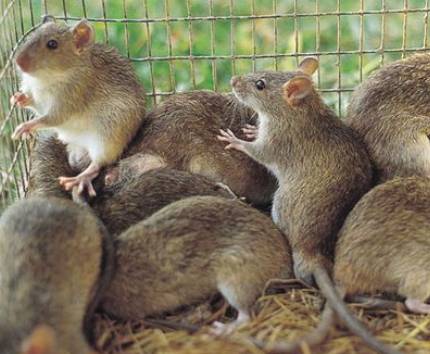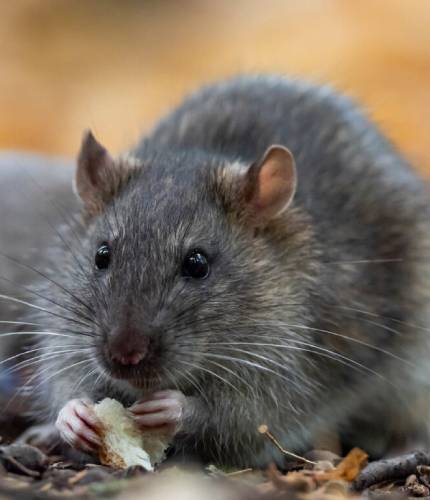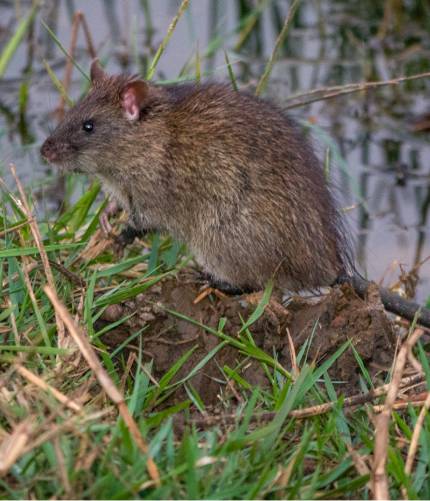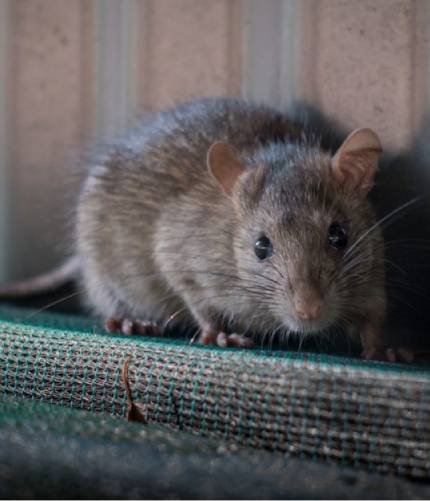Rodents
Rodents: Rats and Mice
Rodents are a large group of mammals with over 1500 representative species worldwide. This means that upto 40% of mammals consist of one group of rodents.
Rats have lived in close association with man ever since the dawn of civilisation, when he gave up nomadic life and settled down to farming with a roof over his head. In spite of living close to man and sharing his food and abode, rats have always remained undomesticated.
Rodents are most easily distinguished from other mammals by the characteristic arrangement and form of their teeth. They have only a single pair of incisors in both upper and lower jaws and no canines. The wide gap (diastema) between the paired incisors and the molars gives the rodent skull an unmistakable appearance.
The incisors form the clue to the tremendous success of rodents in the animal kingdom. Rodent incisors have three basic characteristics that together distinguish them from the teeth of most other animals; they are strongly curved, they grow continuously throughout the animal’s life, and they carry a thick layer of enamel on the outer side only.



The fact that rodents’ incisors grow continuously means they must also be worn away continuously. It is often said that rodents must gnaw in order to prevent their excessive growth, but this is not necessarily true. Rodents can wear away their incisors by rubbing the lower set against the upper set. This results in softer dentine wearing more rapidly than hard enamel, giving a chisel like outer edge to the teeth. In the gnawing of rats and mice, they can penetrate soft metals such as lead and aluminium.
Rats and mice are now present throughout the world. Their adaptability has enabled them to survive extremes of climate, from the frozen tundra to dry, arid deserts. They were among the first animals to be fired from the earth in rockets. They also played a major role in the development of modern medicine.
Rats and mice are collectively called commensal rodents. The word commensal means “sharing one’s table. Rats and mice have been sharing people’s food and shelter for many years. The word rodent means “to gnaw.” Like all rodents, rats and mice possess chisel-like incisor teeth, which grow continuously throughout their lives. These incisors are kept filed and sharp primarily by the rodents grinding them against one another and, secondarily, by the rodents constantly gnawing on various objects.



There are three species of commensal rodents, which are of most concern to pest control professionals.
Types of Distribution
In India, there are about 136 species of rodents recorded. However, about 15 to 16 species are of economic importance. These can be divided into 4 broad groups based on their relationship with man.
- Domestic rodents : Living with man and sharing his food. These rodents nest and live in human habitations.
- Commensal rodents : Living on man but not with him. They prey on his food and live on refuse from men. They sometimes enter human habitations in search of food but do not remain there.
- Field rodents : Living on man but away from him. These rodents live in cultivated fields and consume agricultural produce.
- Wild rodents : These rodents live in the wild and in forests away from humans.
Transmission of Diseases
The diseases transmitted by rodents and other animals to men are known as zoonoses, and there is a wide range on a worldwide basis.
Plague
- This is spread from rats and mice. Also known as the Black Death. This is spread from rats to man by a Flea, Oriental rat flea, Xenopsylla cheopis. Fleas transmit the plague bacterium Yersinia pestis from infected rats to man. The more recent outbreak of plague in India highlights the continuing threat presented by this disease.
- The rapidly growing human population in urban areas and the frequent failure of support services such as refuse collection and sewerage disposal to keep pace with these increases, mean conditions that are conducive to rodent infestation abound: Plague is certainly not a disease of the past. Other diseases cause significant mortalities in humans but do not attract the same publicity as plague.
Leptospirosis or Weils Disease
- Leptospirosis or Weil’s disease, is worldwide, causing a large number of deaths every year, including in India. The bacteria live in the rat’s kidney and are excreted in the rat’s urine. Human infection can occur following contact with water contaminated with rat urine. This has become very common in metropolises like Mumbai, especially during monsoon flooding.
Salmonellosis
- Food poisoning or Salmonellosis is the name given to the infection of Man by organisms of the bacterial group Salmonella. Our concerns are of those types of rodents which may be passed on to man in contaminated food and liquids causing illness and even death. Rats and mice reflect the environment in which they live and must be seen as the potential. Rodents also feed on food-contaminated bacteria, thus they will pass them on through their droppings and urine further contaminating food intended for human and cattle consumption.
Murine Typhus Fever
- This is caused by Rickettsia typhi. Rats carry the disease organisms and rats fleas transmit this to humans. The organism enters the man’s bloodstream when faeces of infected fleas are scratched or rubbed into a flea bite or other break in the skin through injury.
- The full cost of the impact caused by rodent-borne diseases is rarely identified. It is not only the mortality that needs to be considered but also the debilitation suffered by the survivors, costs of hospitalization and treatment, loss of work, etc. which needs to be borne in mind.
Rodents as economic pests
- Rats and mice attack our food on the farm, orchard, and livestock facilities, during its processing, storage and transport, as well as in supermarkets, restaurants and homes. And what the rats and mice don’t eat, they spoil by contaminating it with their urine, faeces or fur. Experts estimate that rats and mice destroy enough food each year to feed over 200 million people.
- In buildings, rodents damage doors, floors, ceilings and walls as a result of their burrowing and gnawing activity. They also regularly gnaw on various utility pipes and electrical wirings which have resulted in explosions, indoor flooding, fires, equipment malfunctions, and power shortages.
- In today’s high-tech production, rodents are capable of causing millions of monetary value in production losses due to shutdown of complex computer systems when they nest or excrete wastes inside computers and other sensitive equipment.



Commensal rodents
- The House Mouse - Mus musculus
- The Bandicoot Rat - Bandicota bengalensis
- The Roof Rat - Rattus rattus
- The Norway Rat - Rattus norvegicus
House mouse: Mus musculus
House mouse is identified by a small slender body weighing around 15 to 25 grams as an adult. Ears are large; tail is semi naked and is as long as the head and the body together, dark grey in colour.
- Body wt. 20 - 25 Gms.
- Small sized rodents
- Tail equal or little longer than body
- Nose pointed, slender body, ears large, prominent and thin
- Brownish-grey to blackish
- Climbs, gnaws, lives indoors and outdoors



Biology and reproduction
When the living conditions are very good (plenty of food, water and shelter) rodents can multiply. The female produces
- Body wt. 20 - 25 Gms.
- Small sized rodents
- Tail equal or little longer than body
- Nose pointed, slender body, ears large, prominent and thin
- Brownish-grey to blackish
- Climbs, gnaws, lives indoors and outdoors
Bandicoot rats: Bandicota bengalensis
Bandicoots are known as field rats and have stocky bodies and are larger, stronger, and more aggressive. This rodent is also found in fields and causes enormous damage. They have burrowing habits. In urban areas, this rodent is often found near garbage dumps, railway tracks, outside buildings and apartments. Their presence is confirmed by the presence of burrows around the buildings.
- Body wt. 600- 750 Gms.
- Medium to large sized rodents
- Tail shorter than body
- Blunt snout, stocky body, ears short and thick
- Brown to black
- Burrowing habit swims and dives easily, live indoors and outdoors in sewers and drains.






Roof rat: Rattus rattus
The roof rat is also known as the black rat, ship rat. The roof rat is appropriately named because by nature it is good climber and commonly lives above the ground in “roof” or aerial areas around structures. Their nests may be located in trees, clinging vines or on the sides of buildings and fences or inside buildings in attic area, ceiling voids. Roof rats enter buildings from the roof or by using various utility lines. If population builds up they expand their nesting areas to include underground burrows within industrial and residential landscape areas, ground floor areas inside buildings, under pile of rubbish.
- Body wt. 250-300 Gms.
- Medium sized rodents
- Tail longer than body
- Nose pointed, slender body, ears large, prominent and thin
- Brownish-grey to blackish
- Good climber, gnaws, often live off the ground in trees, vines, live indoors and out doors
At Truly Nolen India, our rodent control service involves using a 5-step IRPS method, including thorough inspection, identification, and determination, followed by effective prevention and continuous communication. Our comprehensive pest control for rats approach ensures long-term protection against rodent infestations, safeguarding your property from further damage. For more information about our pest control services, contact us today!
Our Clients













Truly is present in more than 37 cities across the country, having more than 400 employees. TPS is currently serving 4000+ commercial and 10000+ residential clients, with an increasing list of clients on a daily basis.
- 915, Hemkunt Tower, 98 Nehru Place, New Delhi -110019.
© Truly Nolen 2023 . All Right Reserved. Designed By Verve Media.
